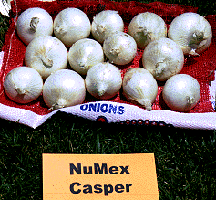NuMex Casper

NuMex Casper was developed by Professor Joe Corgan of the Department of Agronomy and Horticulture. In 1978 , the following varieties were intercrossed: Temprana, Snow White, New Mexico White Grano, and a white selection from Texas Grano 502 PRR. Populations from each variety resulting from the intercross were subjected to two recurrent mass selections. In 1983, selected bulbs from each population except Snow White were selfed, the progenies were screened, and selected bulbs from selected progenies were selfed for a second generation. Selected bulbs from the second self were intercrossed to produce 9076 (NuMex Casper). The 9268 selection is a seed increase from 9076. (To the right is a picture of NuMex Casper (97).)
Progenies in Snow White cytoplasm were excluded in order to exclude S cytoplasm. The result is that NuMex Casper is a mixture of N and S cytoplasm. A few male sterile plants are produced, but the frequency is less than five percent, and not enough to influence seed yield significantly. The presence of S cytoplasm will be an advantage to onion breeders who wish to develop A and B lines from NuMex Casper. Criteria for selection include pink root resistance, bulb depth and shape, bulb firmness, bulb color quality, and intermediate maturity. NuMex Casper matures about July 10 when spring-seeded in Las Cruces, New Mexico. When it is transplanted in the spring, maturity is June 22 to 28. Maturity is uniform, and color quality is excellent. Bulb shape is predominantly high globe, with excellent depth.
Yields of NuMex Casper have been excellent in both pink root and non-pink root fields, form both direct seeding and transplanting. NuMex Casper is most like Midstar, an intermediate white hybrid that is commonly grown in New Mexico. Bulb depth is greater than for Midstar. NuMex Casper also consistently produced a higher percentage of marketable bulbs than Midstar. Testing has shown NuMex Casper to be equal to or better than any other comparable variety in each category tested.
NuMex Casper is suggested for transplanting or direct seeding wherever intermediate-onion varieties are grown. It is highly promising for production in southern New Mexico.